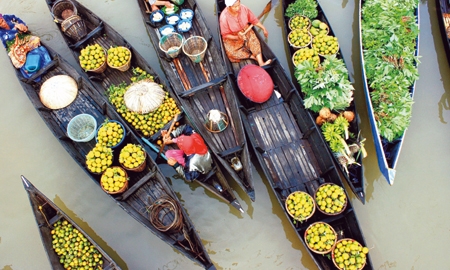The extreme beauty and diversity to behold in the world’s largest archipelago is drawing ever-increasing numbers of visitors each year and making tourism one of the top five contributors to Indonesia’s revenues, after oil and gas, coal, palm oil and manufactured rubber. Concerted efforts by the Indonesian government to expand the tourism sector with favourable economic policy-making and international advertising campaigns look set to add further momentum to the industry’s growth.
Comprising more than 17,500 islands straddling the Equator and stretching out across some 735,000 square miles, Indonesia’s rich mix of natural splendour, fascinating culture and magnificent flora and fauna attracted 8.8 million foreign visitors in 2013, representing a 9.4 per cent increase on the previous year.
In total, more than 8 million people visited the country in 2012 and the Indonesian government hopes to have welcomed between 9.3 and 9.5 million foreigners by the end of 2014. Such aims look achievable: in 2007 5.51 million visitors came from overseas and the number of foreign tourists has steadily risen year on year.
A report by the OECD shows that the average visitor stays for just over one week and spends $1,118 – a substantial amount considering there are still 100 million Indonesians living on just $2 a day.
Income generated by tourism hit $10.1 billion in 2013 up from $6.3 billion in 2009. According to World Travel and Tourism Council Data, tourism and travel contributed 9 per cent (or $85 billion) to Indonesia’s GDP last year, and has hovered around the nine to 10 mark for the last 10 years. In 2013, it employed 9.4 million people, accounting for 6.4 per cent of the national workforce in 2013, either directly or indirectly.
Therefore, it is easy to understand why tourism is recognised as one of the country’s main economic pillars and one of the key drivers of national economic growth. It features in the government’s MP3EI economic master plan – its vision of how to propel Indonesia into the world’s top 10 economies by 2025. The plan also highlights Indonesia’s untapped potential for the meetings, incentives, conferences and exhibitions (MICE) market.
| Tourism is one of the country’s top five industries, with revenues representing 9 per cent of its GDP, and there is huge potential to develop the sector further |
Various local and national agencies have been launched to attract tourists and the national tourism office promotes ‘Wonderful Indonesia’ around the world at international promotional fairs, accompanied by a global advertising campaign. In addition, local regions run their own organisations. For example on Bali, the Tourism Information Centre promotes the island’s local tourism industry as well as a variety of other provinces.
Bali is the country’s most popular tourist destination. Incredible beaches line its shores, while inland beautiful lush green rice fields and forests filled with fascinating wildlife refresh the senses. Its rich cultural heritage can be seen in the plethora of temples that dot the landscape and traditional dances and ceremonies that encourage visiting spectators.
Most foreign arrivals enter Indonesia through the newly renovated Ngurah Rai International Airport on Bali, followed by Soekarno-Hatta International Airport close to the capital Jakarta on neighbouring Java.
Jakarta itself is filled with sightseeing and tourist attractions, as well as plenty of shopping malls and side streets filled with nightlife, food and fun. On the other side of the island, some four hours’ drive from Surabaya, the capital of East Java, sunrise at the wonderful Mount Bromo volcano, which is a part of the Bromo Tengger Semeru National Park, leaves early risers speechless.
Tourists are being encouraged to look further east, beyond Bali, and discover Indonesia’s eastern delights on Lombok, Sumbawa, Komodo, Flores, Sumba, West Timor and the Solor and Alor Archipelagos. The MP3EI’s economic corridors are part of the push to expand the tourism industry on those islands and highlight the incredible experiences visitors can have – for example seeing the colourful Kelimutu Crater Lakes on Flores or Komodo’s famous dragons – and create memories to last a lifetime.

0 COMMENTS